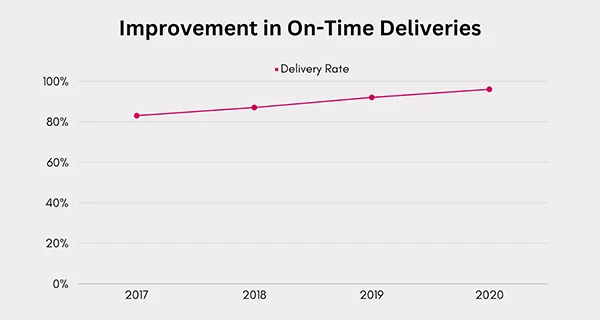Streamlined Scheduling: Boosting Profit Margins in Logistics
Efficient scheduling forms the backbone of profitable logistics operations. However, traditional practices pose significant challenges. They hinder productivity and cripple bottom lines. There is an urgent need for solutions that streamline scheduling. You only need to look at the following:
- Inefficient resource allocation
- Lack of visibility
- Scheduling conflicts
Logistics companies that rely on outdated methods encounter significant inefficiencies. Approximately 20-30% of logistics resources are underutilized due to poor scheduling. Their costs account for 10-15% of total sales.
Moreover, not having real-time information makes problems worse. Many professionals consider real-time visibility vital for informed decision-making.
However not having real-time tracking raises logistics costs by 10 to 15 percent. Conflicts also arise, with 30% of issues stemming from disputes over timing.
Now, let’s delve into the challenges associated with conventional scheduling in logistics. There is a strong need for new ideas. Let’s explore how user-friendly planning tools can bring about significant improvements. We will talk about how they can solve these problems directly.
Streamlined Scheduling Solutions
Using simple timetable tools makes logistics tasks better and improves bottom lines.
Automation and AI
Automation and AI create improved schedules by utilizing data to determine the optimal resource allocation. AI-driven math can look at big piles of data.
It can be used to find out what is not working well and guess the best times for doing things. Machine learning continuously refines its suggestions, leading to further enhancements.
Moreover, automation makes routine schedule duties like handling calendars easier. This frees up workers’ time. Automation and AI in a dock scheduler make us more productive by 15-25%.
Also, automation can cut down on running costs by as much as 40%. At the same time, AI-based scheduling raises resource use by 10 to 20 percent.
Predictive Analytics
Predictive analytics leverages the following to forecast possible issues:
- Historical data
- External factors
- Machine learning
These measures assist delivery companies in reducing wait times, optimizing routes, and preventing unexpected delays.
Precisely, predictive analytics tools can connect with real-time Internet of Things (IoT) sensors. It is used for all cars and machinery. By looking at this data, businesses can spot signs of failures before they happen. They can set up regular maintenance to prevent problems and stop disruptions.
Also, machine learning programs can find problems as they happen. They can suggest changes, making a loop to keep things improving all the time. Leveraging forecasting tools can halve unexpected shutdowns and significantly improve on-time deliveries.
Real-Time Monitoring
Real-time tracking provides a clear view of all ongoing logistics activities. IoT sensors and GPS tracking relay live updates on location, weather, traffic, and equipment diagnostics.
This data powers dynamic dashboards that enable dispatchers to visualize operations. Companies can make data-driven decisions. Immediate access to real-time insights results in a 20% reduction in idle time as resources are optimized. Real-time fuel usage monitoring further decreases fuel costs by 15%.
Moreover, 80% of logistics professionals believe that real-time visibility enhances decision-making. With access to enhanced data, teams can achieve the following:
- Respond to disruptions
- Adjust routes
- Balance workloads for great efficiency
Now, the focus is on fast scheduling systems. So, it’s pivotal to know the great advantages they give. Let’s find out how these answers do more than just fix problems. This also results in real benefits for businesses that handle logistics.
Benefits of Streamlined Scheduling

Cost Reduction
Improving schedules yields cost savings in various areas. First, using guessing math and up-to-date views can save on fuel by 10 to 15 percent.
This results in more efficient routes and reduced idle time. Simple planning also reduces work costs by making sure equal jobs and not extra hours.
Automation and AI help save money on equipment costs by 15-20% by making the best use of things. In the end, easy planning helps logistics companies save money by 20-30%.
Improved Customer Satisfaction
Good planning makes sure things are delivered on time and there are fewer mistakes. It directly turns into better customer happiness.
Logistics firms can spot possible hold-ups thanks to tracking in real-time. They can also change plans so they still reach delivery times. This prevents missed deadlines, which can erode customer trust.
When customers are more satisfied, they stay longer and recommend your business to others. This helps keep profits steady in the long run. Experts suggest that simplifying scheduling can retain customers for 20-30% longer.
Competitive Advantage
Streamlined methods provide logistics companies with a competitive edge. This is due to the boost in efficiency and how it reduces costs. Leaders in logistics automation and real-time visibility gain an advantage in the following:
- Pricing
- Reliability
- Customer experience
This competitive advantage empowers companies to secure a larger share of the market. Industry leaders in streamlined scheduling gain 10-20% market share over competitors in 2-3 years.
We have demonstrated the significant advantages of user-friendly scheduling. The next obvious step is to look at how companies can set up these plans. Ultimately, realizing these benefits requires effective planning and execution.
Implementation Strategies
To successfully install streamlined scheduling, companies should:
Assess Current Processes
Check the current workflow for planning to find problems and slow spots. This gives the information needed to make good changes.
Choose the Right Tools
Select scheduling software and technologies that align with business needs about:
- Scalability
- Integration
- Ease of use
This makes sure you get the most worth and cost back.
Train Employees
Good teaching helps workers get used to new ways of doing things. Focusing on change management facilitates the acceptance and adoption of improved schedules by employees.
Before we finish, let’s talk about some common questions. These happen when thinking about using easy-to-follow schedules. Understanding these common questions and answers will assist you in enhancing your grasp of logistics improvement.
Frequently Asked Questions
Ans: The time it takes to see a return on investment changes depending on the situation but usually lasts 6-12 months. Businesses can make it quicker by focusing on major changes first.
Ans: Possible problems could be fitting in with old systems, working methods, and habits. Making good plans can help to reduce these dangers and make the launch go smoothly.
Ans: Yes, small businesses can use solutions like real-time watching and guessing analytics. These are good choices for affordable, organized planning.
Takeaway
Streamlined scheduling solutions empower logistics companies to achieve the following objectives:
- Boost efficiency
- Reduce costs
- Improve profitability
Through the use of automation, specialized forecasting tools, and real-time tracking, companies can overcome their existing challenges. At the same time, they will get an edge in competition. To realize these benefits, companies must follow these practices:
- Critically assess current processes
- Install appropriate tools
- Train employees on new systems
The benefits reaped by logistics companies using straightforward scheduling are truly remarkable.









